

 Vol. 40 (Number 41) Year 2019. Page 11
Vol. 40 (Number 41) Year 2019. Page 11
LUCHANINOVA, Olga 1; KOVAL, Viktor 2; DEFORZH, Hanna 3; NAKONECHNA, Liudmila 4 & GOLOVNIA, Olena 5
Received: 02/08/2019 • Approved: 17/11/2019 • Published 25/11/2019
ABSTRACT: In this article the authors report on the research conducted to study the general and the specific features attributed to the formation of the communicative competence of the future specialists, when this type of competence is developed by means of group work under conditions of a contemporary institution of higher education. Communicative competence is expressed in the ability to carry out the self-assessment and in the level the interpersonal experience formed for the effective performance of their professional activities. The model engaged in the development of communicative competence by means of group work has been checked for the effectiveness of its influence on the development of communicative competence of the above mentioned professional group and it has been experimentally verified that the student’s general competence of high level increased. |
RESUMEN: En este artículo, los autores informan sobre la investigación realizada para estudiar las características generales y específicas atribuidas a la formación de la competencia comunicativa de los futuros especialistas, cuando este tipo de competencia se desarrolla mediante el trabajo grupal en condiciones de una institución contemporánea de educación más alta. La competencia comunicativa se expresa en la capacidad de llevar a cabo la autoevaluación y en el nivel de la experiencia interpersonal formada para el desempeño efectivo de sus actividades profesionales. Se ha verificado la eficacia de su influencia en el desarrollo de la competencia comunicativa del grupo profesional mencionado anteriormente y se ha verificado experimentalmente que la competencia general del estudiante de alto nivel aumentó . |
The contemporary educational paradigms direct the process of professional training of future specialists not only to the sphere of educational disciplines, but also to the student's personality and professional development in the society and during performing the professional activities. Therefore, specially organized communicatively oriented training of future specialists, translators in particular, is a component of their general professional training.
The topicality of this research is explained by the existing contradictions which are revealed in the form of the non-compliance between the requirements of the society for the individual to have the communication competence and the low level of communicative training for students in institutions of higher education. The non-compliance is also found between the implementation of a new educational paradigm of higher education aimed at creating the conditions for the professional and personal growth and the self-fulfilment of future specialists, and the outdated paradigm in the methodology, the theory and the practice implemented in the institutions of higher education. It is known that the communicative competence of a person developed in the process of professional training is its logical result. This is one of the professionally significant qualities of a future specialist. Specially organized and communicatively oriented training of future translators is determined by educational qualification requirements.
The purpose of the study is to justify theoretically and verify practically the organizational and pedagogical conditions of students' communicative competence development.
The purpose of the study is to perform an experimental verification of the pedagogical conditions of formation the communicative competence of the students-translators. We presume that the formation of communicative competence of students-translators will be effective in the conditions of creating situations of success, enhancement of educational motivation, use of engaging group forms of work during the lessons, encouraging students to do personal reflection.
The research objectives are to perform an analysis of the scientific literature; to clarify the concept of the "communicative competence of a translator"; to substantiate and check the pedagogical conditions of the formation of communicative competence of students-translators; to work out a theoretical model of formation of the communicative competence of translators.
The theoretical methods that were used in the work include comparison, analysis of literature in order to clarify concepts, synthesis, modeling as well as empirical methods such as diagnostic methods in the form of questionnaires, methods of qualitative and quantitative processing of the results. The study has covered the students-translators at the Departments of Foreign Language and Translation at the National Metallurgical Academy of Ukraine (32 individuals)
Every day we communicate in the personal or professional environment. This is contributed by the communicative competence of the person that he or she possesses at different levels, depending on the age and his or her competence. There are many methods in education that are targeted at building such competence.
The methods and means of group work with students, which help in the formation of the communicative competence of translators, remain beyond the attention. It should be pointed out that the graduates of higher education institutions are not ready to build their verbal and non-verbal communication sufficiently as well as they are not taught the method of communicative activity for effective coordination of cooperative activity and the method of building of mutual understanding. We are urged that the professional team should familiarize the students with the examples of group work, which engage close communication.
Hence, the innovative methods of using group forms of work with the students during the lessons and the cooperative interaction for the sake of formation of communicative competence of the future translator, which keep their main attribute, is the motivation for the increasing of the level of communicative competence.
Research by scholars testifies that the definition of "communicative competence" is treated depending on the situation in which the person is located and it is noted that communicative competence can be defined as a synonym for the concept of "competence in communication" and includes a system of interpersonal interaction (Nikolayev, 2003; Rickheit & Srohner, 2008).
The concept of «communicative competence», competence and its varieties, scope, professional features are analyzed in detail in the works of domestic and foreign scientists: the practice of improving communicative competence, diagnosis and development of competence in communication (Rickheit & Srohner, 2008); place and role of communication in public policy (Romanenko, 2016 ); communicative competence in the professional activity of the teacher (Melnyk, 2012); communicative competence of specialists of the customs service in the system of continuous professional education (Pavlenko, 2010); directions in sociolinguistics and communication ethnography (Heims, Gamperz, 1972); development of corporate competence, communication with communicative (Tate, et al., 1995); language and communicative competence (Besnier, 2013); communicative competences in enhancing regional competitiveness in the labor market (Koval, et al., 2018); the essence and specifics of the services marketing system in the mechanisms of public administration (Romanenko & Chaplay, 2016); professional communication in the global business context, communicative competence in language teaching (Celce-Murcia, 2008; Louhiala-Salminen, & Kankaanranta, 2011; Young, & Sachdev, 2011), etc.
The International Standards for Training, Performance and Instruction (IBSTPI), developing and adopting standards for professionals in the areas of training, development and productivity, defines the concept of "competence" as the ability to carry out a qualified activity, perform task and work (Koszalka et al, 2013).
The Association for Educational Communication and Technology (AECT) is actively involved in curriculum development and the development of a systematic approach to learning, a wide range of educational technologies.
Delamar and Winterton (2005) argue that competencies are necessary for effective work and can include conceptual (cognitive, knowledge and understanding) and operational (functional, psychomotor and applied skills) competencies. Competences related to individual effectiveness also include conceptual (meta-competencies that include "learning to learn") and operational (social competences that include behaviour and relationships).
For example, Spencer & Spencer (1993) are authors of a behavioural approach when it comes to competences that are considered synonymous with the concept of "competence". According to our study, it is important that the behavioural component involves the formation of skills to realize communicative competences directly in the context of professional and business communication.
Thus, the term "communicative competence" was introduced into the scientific space by Gamperz & Hymes (1972) and other American scholars consider communicative competence as an ability that is formed in the process of interaction between the individual and the social environment.
Beyond the attention is the development of the communicative competence of the future translator by means of group work. The components of the communicative competence of these students are different types of competences (European Recommendations on Language Education, 2003): socio-cultural competence (knowledge of the particularities of a country and language, the ability to act within this society); speech competence (speech, listening, reading, writing); pragmatic competences – general teaching skills and abilities: to listen, to perceive, to analyze, to build speech situations); discursive – is the ability to control speech and structure it according to the topic; functional – the ability to thwart all forms of speech utterances; competence of interaction – the ability to social interaction in certain schemes, models) (Nikolayev, 2003).
In general, communicative competence is defined as communicative management, which involves not only language knowledge, but also the appropriate level of its practical possession, depending on the particular speech situation (Pavlenko, 2010).
Consequently, in the context of our study, it is necessary to clarify the concept of "communicative competence" through such concepts as "totality", "activity", "ability", "readiness", "experience", skills and skills that are manifested in conditions of direct interaction – educational, professional or vital. We submit the author's refinement of this concept, namely: "communicative competence of the future interpreter" is an integrated concept, a set of knowledge, skills, abilities and experience necessary for an interpreter to carry out professional activities (work with information, creating a translation, organizing the search for a professional translator, terminological information, cognitive activity, etc.). It (concept) consists of the linguistic, sociocultural, strategic, pragmatic, functional, interactive components (definition of the author).
In the educational process of development of communicative competence, in our opinion, contribute to different means of group work. Work in small groups of students on the principle of working in temporary groups while executing part of the task contributes to the development of many personal qualities of students, united by a common educational purpose.
Graduates of higher education institutions are not prepared more often than not ready to build relationships with various communication partners do not teach effective communication methods for effective coordination of joint activities and building mutual understanding. During the group work in the process of interaction, an overall solution is reached, students learn to break through their constant thoughts, find a new way of thinking and solving the problem. The value of such work: the development of leadership skills, the great power of persuasion; more self-confidence; more responsibility; improvement of communicative skills, etc. (Keiner et al, 2014).
Consequently, the use of group forms of work is one of the conditions for the formation of the communicative competence of the future translator, which retains its main property – to be a form of cooperation in the learning process, to create conditions for communication.
Since the conditions are the necessary circumstances, the peculiarities of reality that make it possible to carry out the corresponding process and «pedagogical conditions» are determined by the relevant circumstances of the pedagogical process of professional training of specialists, then we define the pedagogical conditions as the result of selection, the application of different elements of teaching and its organizational forms. The development of communicative competence is necessary for the implementation of professional activities, which allows them to increase the compliance of skills and abilities in accordance with the requirements of the internationalization of companies and participation in global value chains (Labunska et al., 2017; Koval et al., 2019).
In our opinion, effective pedagogical conditions for forming students' communicative competence are creating situations of success, enhancing learning motivation, using interesting group forms of work during classes, encouraging students to reflect on themselves.
The lecturer should be a facilitator of the students' educational activity which includes the contribution into conducting of the lesson on a high emotional level, to guide their educational motivation onto finding forms of group work that would be interesting for them. The more the student works independently, seeking for the information, proving his opinion in the group during the dialogue and performs creative tasks by the means of pedagogical coaching, “battles”, the brighter his communicative abilities reveal.
The abilities as well as the communication skills are namely the ones that underlie communication competence. They are the result of the experience of communication between people. The student-translator at the end of the lesson can do a personal reflection, to analyze the obtained knowledge and skills at the emotional level, make a decision regarding deepening of their communicative competence.
We present a structural and functional model of communicative competence formation of students-translators, in which all the stages of this process are shown and include finding methodological foundations (principles, concepts) as well as creating pedagogical conditions, means and methods of the formation this competence to adjusting all the forms of work in the constitutive stage of pedagogical experiment; organization of methodological support; the content of formation of the communicative competence of students-translators; implementation of actions aimed on formation of the students' communicative competence; systems of conversational interaction of the teacher with the students and the result.
In order to master communicative competence, students-translators are to use the methods of group work that are most effective during personal interaction. For instance, students think independently during the discussion and follow the thought of a dialogue partner as well as seek information on problematic issues, actively discuss it, also learn to listen to the opinion of another person without criticism and objection.
The teacher may offer a brainstorming session during the discussion whereas in a short period of time students gather thoughts and ideas to solve a problem and make a joint decision. Pedagogical coaching is effective during the group work: students learn to establish not only visual and ethical contact with a communication partner, but also form communicative competence by means of specific thematic assignments.
Students learn thematic and professional communication in class. At the beginning, the lecturer-facilitator monitors the emotional state of those who communicate. It is not always possible to build an extended dialogue on a given topic. The lecturer-facilitator encourages the discourse of each participant through verbal and non-verbal methods. Students can play a role of a teacher and teach others the exact words that were used in translation. Pedagogical bingo or battles, role playing games, press method, mosaic are interesting forms of activities.
At the ascertaining stage, we have discovered the overall level of communicative competence of the students-translators. Diagnostic techniques were used for 32 individuals from groups of 4 year student translators, who were divided into two groups: CG (control group) – 16 persons, EG (experimental group) – 16 persons. We have chosen the following diagnostic techniques:
1) "Self-control in communication" – Snyder's testing (Snyder, 1974), which involves the distribution of levels of communicative control over gradation, emotional restraint and control of their behavior when interacting with others;
2) "As far as you are communicative" – adapted methods Ryakhovsky (1998), allowing to quantify the level of human sociability. We adapted the questionnaire specifically for student translators who work with technical texts of metallurgical content.
At this stage, after studying the theoretical sources, criteria were developed that helped determine the level of formed communication competence of students-translators which include motivational, speech and practical criteria; levels of communication competence: sufficient, medium, and low level. When we worked out the questionnaires, we found out that the students-translators of both groups have almost the same level of control during communication, but do not seek professional communication. They are satisfied with personal communication. The results of the questionnaire give us a reason to move on to the following considerations and preliminary conclusions.
Thus, in life situations, translators show a sufficient level of the formation of communication competence. While working on the learning situations, it was difficult for the students to find words, thoughts, and cues that would fit the topic. Consequently, the communicative competence of CG and EG students by the three criteria is approximately at the same level. At the constitutive stage, the students of the control group studied as usual. The students of the experimental group were divided into separate groups in order to perform different assignments.
On practice, each pedagogical condition has been experimentally tested. According to the first condition there have been creating of situations of success, strengthening of the educational motivation (motivational criteria) of students who were motivated to communication by means of creative tasks, group interaction, discussions.
According to the second pedagogical condition there has been the use of interesting group forms of work during the lessons when students-translators worked in pairs, played role-playing games (teacher, business partner, etc.), studied theoretical knowledge through pedagogical bingo, battle, coaching, and performed creative tasks.
According to the third pedagogical condition, students were encouraged to do a reflection.
Figure 1
The Levels of development of the general communicative
competence of students of CG and EG at the stage of formation
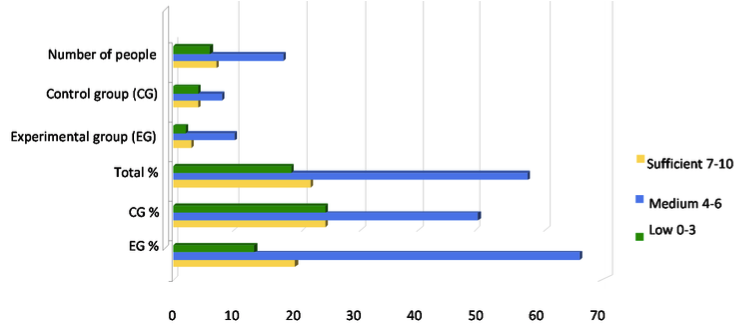
The diagram (Fig. 1) clearly shows that the students of both groups prevail in the average level of overall communicative competence, which indicates their specific training, since these are future translators for the 4th year of undergraduate studies.
Figure 2
The Levels of development of communicative competence of students of Control Group
and Experimental Group based on the motivational-value criterion at the qualifying stage
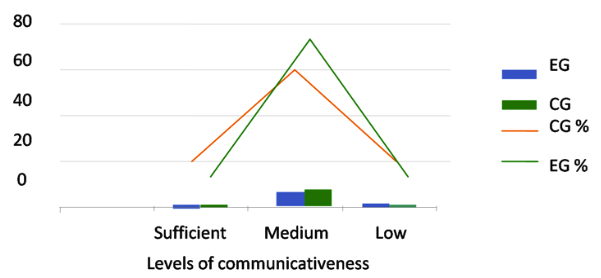
For students of the EG the motivation-value criterion is sufficient and the average level is lower than for students of the CG (Fig. 2). This indicates a lack of communication as a value, or at this moment, students are more motivated to study other disciplines, to work, etc.
Figure 3
The Levels of development of communicative competence of
students by operational criterion at the qualitative stage
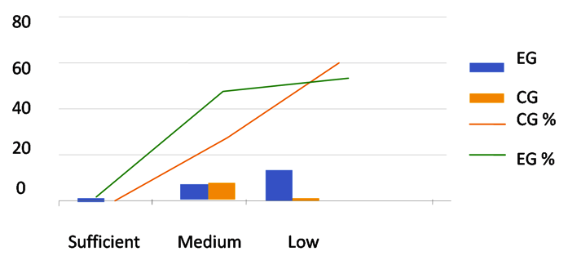
It is evident from the table and diagram (Fig. 3) that there is no adequate level for the students of the EG, although the average is higher than in the CG. The low level of YE students is also lower. This suggests that they do not use communicative knowledge and skills in practice, do not seek to do so.
Thus, in life situations, translators show a sufficient level of the formation of communication competence. While working on the learning situations, it was difficult for the students to find words, thoughts, and cues that would fit the topic. Consequently, the communicative competence of CG and EG students by the three criteria is approximately at the same level. At the constitutive stage, the students of the control group studied as usual. The students of the experimental group were divided into separate groups in order to perform different assignments.
On practice, each pedagogical condition has been experimentally tested. According to the first condition there have been creating of situations of success, strengthening of the educational motivation (motivational criteria) of students who were motivated to communication by means of creative tasks, group interaction, discussions.
According to the second pedagogical condition there has been the use of interesting group forms of work during the lessons when students-translators worked in pairs, played role-playing games (teacher, business partner, etc.), studied theoretical knowledge through pedagogical bingo, battle, coaching, and performed creative tasks.
Figure 4
The Levels of formation of main communicative competence
of students of CG and EG at the control stage
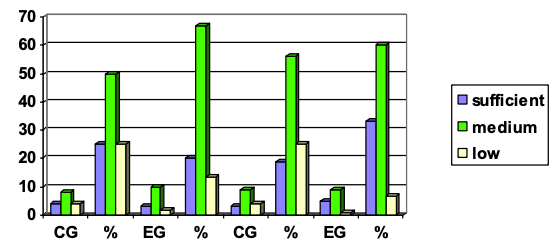
As it can be seen from the diagram, the students of EG have a high level of communicative competence has increased by 14% and the average level has increased by 7%. The low levels have decreased by 7%. The CG students have a high level of communicative competence decreased by 6.0%, the average indicator has increased by 6.0%, and the low level has not changed. At the control stage, we have received the following data on the motivational, cognitive, and operational criteria.
Figure 5
The levels of the students’ of the EG and the CG communicative competence
formation according to the motivational criterion at the control stage
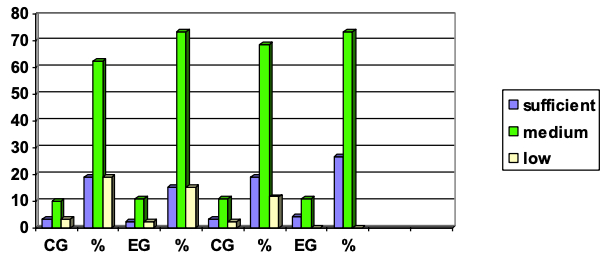
As it can be seen from the diagram (Fig. 5), the low level of communication competence of the students of the EG has decreased by 15.3%, the average level of students has not changed, and the indicators of the sufficient level have increased by 15.3%. For CG students, the low level has decreased by 6.3%, the average level by has decreased by11.5%, and the sufficient level has not changed.
Figure 6
The levels of communicative competence formation (EG and CG)
according to the speech criterion at the control stage
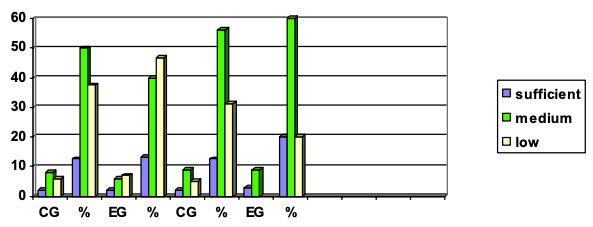
As it can be seen from the diagram (Fig. 6), the low level of communication competence of the students of the EG has decreased by 27%, the indicators of the sufficient level have increased by 6%, the average level has increased by 21.0% and, the low level of communication competence of students has decreased by 6.3% in the control group, and the indicators of a sufficient level have not changed, the average level has decreased by 6.3%
Figure 7
The levels of communicative competence formation (EG and CG)
according to the practical criterion at the control stage
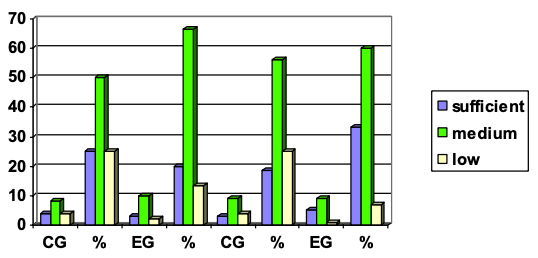
-----
Figure 8
Dynamics of communicative competence formation (EG and CG) according
to the motivational, speech, practical criterions at the control stage
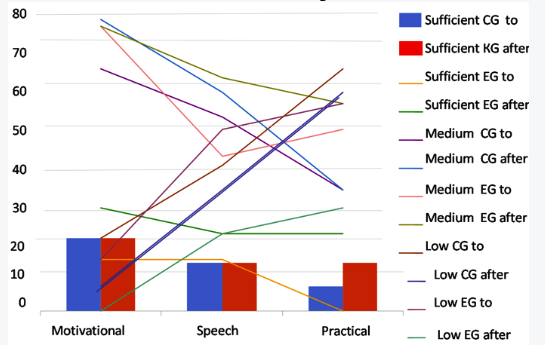
The final diagram (Fig. 7 & 8) shows that the low level of communication competence of the EG students has decreased by 27%, the average level has increased by 21.0%, and the sufficient level has increased by 6%. The dynamics of communication competence of EG students is mostly observed at the low and average levels. In the control group, the low level of communication competence of students has decreased by 6.3%, the average level has decreased by 6.3%, and the indicators of a sufficient level have not changed.
We observe that it is more difficult for the students-translators as representatives of the institutions of higher technical education to form their communicative competence during the learning process. But this is a large-scale phenomenon that needs to be developed in the higher education using innovative learning technologies according to the changes and the demands in the society. Theoretical substantiation and experimental verification of pedagogical conditions of formation of communicative competence of students-translators have been carried out, among which there were effective ones such as creating situations of success, enhancing learning motivation as well as using an interesting group forms of work during the lesson and encouraging the students to personal reflection. The efficiency of methods and means of formation of the communicative competence of students-translators has been experimentally confirmed.
According to the motivational criteria, the low level of communication competence of the students of EG has decreased by 15.3%, the average level of students has not changed, and indicators of the sufficient level have increased by 15.3%. For CG students, the low level has decreased by 6.3%, the average level has decreased by 11.5%, and the sufficient level has not changed.
According to the speech criteria, the low level of communication competence of the EG students has decreased by 27%, the sufficient level has increased by 6%. The low level of communication competence of students has decreased by 6.3%, the average level has decreased by 6.3% in the control group.
According to the practical criteria, the best results are the following: sufficient level of communicative competence has emerged in EG students. The dynamics of communication competence of students of the EG is most often observed at the low and average levels by the three criteria. Thus, the indicators of sufficient level have increased by 6%, the low level of communication competence of students of EG has decreased by 27%, the average level has increased by 21.0%.
Our pedagogical study has not covered all aspects of this complex problem of formation of the communicative competence of modern high school students. We consider noteworthy didactic conditions of formation of communicative competence of modern students, deepening of criteria and diagnostic material.
Besnier, N. (2013). Language on the edge of the global: Communicative competence, agency, and the complexity of the local. Language & Communication, 33(4), 463-471.
Celce-Murcia, M. (2008). Rethinking the Role of Communicative Competence in Language Teaching. In: Soler E.A., Jordà M.S. (eds). Intercultural Language Use and Language Learning. Springer, Dordrecht.
Delamare Le Deist, F. & Winterton, J. (2005). What Is Competence? Human Resource Development International, 8(1), 27-46.
Gumperz, J. J., & Hymes, D. H. (1972). Directions in sociolinguistics: The ethnography of communication. New York: Holt, Rinehart and Winston.
Keiner, S., Lind, L., Toldy, K., Sarah, F., & Berger, D. (2014). Guide facilitator. How to lead a group to make a joint decision. M .: Izd. Dmitry Lazarev.
Koszalka, T., Russ-Eft, D., Reiser, R., Fernando Sr., C. A., Grabowski, B., & Wallington, C. (2013). Instructional designer competencies: The standards (4th ed.). Charlotte: Information Age.
Koval, V., Duginets, G., Plekhanova, O., Antonov, A., & Petrova, M. (2019). On the supranational and national level of global value chain management. Entrepreneurship and Sustainability Issues, 6(4), 1922-1937. http://doi.org/10.9770/jesi.2019.6.4 (27)
Koval, V., Polyezhayev, Y., & Bezkhlibna, A. (2018). Communicative competences in enhancing of regional competitiveness in the labour market. Baltic Journal of Economic Studies, 4(5), 105-113.
Labunska, Sv., Petrova, M., Prokopishyna, O. (2017). Asset and cost management for innovation activity. Economic Annals – XXI, 165(5-6), 13-18.
Louhiala-Salminen, L., & Kankaanranta, A. (2011). Professional communication in a global business context: The notion of global communicative competence. IEEE Transactions on professional communication, 54(3), 244-262.
Melnyk, E. (2012). Communicative competence as a factor for improving the professional activity of a teacher. Scientific support of staff advanced training, 1(10), 80-84.
Nikolayev, S. (ed.) (2003). European-wide Recommendations on Language Education: Study, Teaching, Evaluation. K .: Lentiv.
Pavlenko, O. (2010). Formation of the communicative competence of specialists of the customs service in the system of continuous professional education of the doctor of pedagogical sciences in specialty (Doctoral dissertation, Oles Honchar Dnipro National University, Dnepropetrovsk, Ukraine). Retrieved from http://lib.iitta.gov.ua/106803/5/dis.pdf
Rickheit, G., & Srohner, H. (2008). The concept of communicative competence. In The handbookof Communicative Competence. Mouton de Gruyter.
Romanenko Y.O. (2016). Place and role of communication in public policy. Аctual problems of Economics, 2 (176), 25-31.
Romanenko, Y.O., & Chaplay, I.V. (2016). The essence and specifics of the services marketing system in the mechanisms of public administration. Actual Problems of Economics, 186(12), 81-89.
Ryakhovsky V., & Rogov E. (1998). The teacher as an object of psychological research: A manual for school psychologists to work with the teacher and the teaching staff. M.: VLADOS.
Snyder, M. (1974). Self-monitoring of expressive behavior. Journal of Personality and Social Psychology, 30(4), 526-537.
Spencer, L. M., & Spencer, S. M. (1993). Competence at Work. NY: Wiley.
Tate, W. (1995). Developing managerial competence: A critical guide to methods and materials. Aldershot, Hampshire, England: Gower.
Yankovyi, O., Goncharov, Yu., Koval, V., Lositska, T. (2019). Optimization of the capital-labor ratio on the basis of production functions in the economic model of production. Naukovyi Visnyk Natsionalnoho Hirnychoho Universytetu, 4, 206-212.
Young, T. J., & Sachdev, I. (2011). Intercultural communicative competence: Exploring English language teachers’ beliefs and practices. Language awareness, 20(2), 81-98.
1. National Metallurgical Academy of Ukraine, Ukraine. E-mail: 2017olgapetrovna@gmail.com
2. Odessa Institute of Trade and Economics of Kyiv National University of Trade and Economics, Ukraine. E-mail: victor-koval@ukr.net
3. Volodymyr Vynnychenko Central Ukrainian State Pedagogical University, Ukraine
4. Vinnitsia Mikhailo Kotsiubynskyi State Pedagogical University, Ukraine
5. Vinnytsia National Agrarian University, Ukraine.